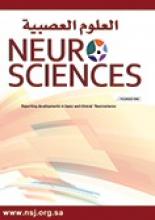Abstract
OBJECTIVE: The objectives of this study were to evaluate the clinical profile, investigations, treatments and outcome of hospitalized children with febrile seizures.
METHODS: A series of 69 consecutive children with febrile seizures was identified by chart review from 1st January 1997 to 1st January 2002 at King Abdul-Aziz University Hospital in Jeddah, Kingdom of Saudi Arabia. Clinical, laboratory, EEG, and neuroimaging data were evaluated by one investigator using a structured data collection form.
RESULTS: The children’s ages ranged between 7-70 months (mean 20, SD 14), and 59.5% were males. The source of the febrile illness was evident in 65%, however, most admitted children (60 out of 69) had atypical seizures (55%), were ill looking (24.5%), had febrile status (17.5%), or positive meningeal irritation signs (4%). Electrolyte abnormalities were uncommon (10%), however, complete blood count was abnormal in 45%, which increased the likelihood of receiving intravenous antibiotics (p=0.01). Lumbar puncture was performed on 75%, particularly those with a first seizure (odds ratio [OR] 3.8, 95% confidence interval [CI] 0.9-15) or younger than 2 years of age (OR 3.4, 95% CI 0.7-17). Brain CT was performed in 13% and EEG in 33%. Obtaining an EEG was less likely if the seizures were typical (13% versus 50% in atypical, p=0.002). Duration of hospitalization ranged between 1-14 days (mean 4.7, SD 3.2), and only one child had meningitis, which was predicted clinically.
CONCLUSION: Pediatricians are selective in admitting and investigating children with febrile seizures. The children frequently had atypical seizures, status epilepticus, or were ill looking. The yield of investigations remains low and does not justify extensive work-up or prolonged hospitalization.
- Copyright: © Neurosciences
Neurosciences is an Open Access journal and articles published are distributed under the terms of the Creative Commons Attribution-NonCommercial License (CC BY-NC). Readers may copy, distribute, and display the work for non-commercial purposes with the proper citation of the original work.






